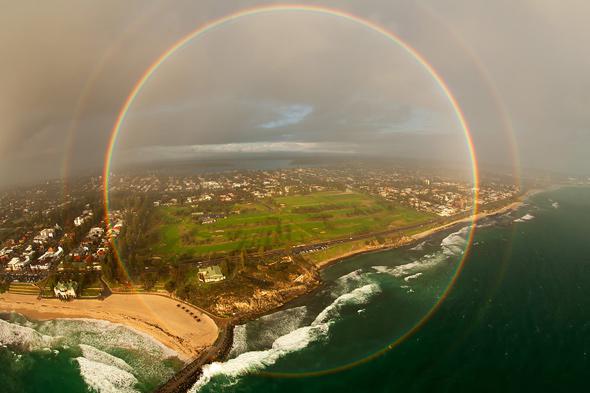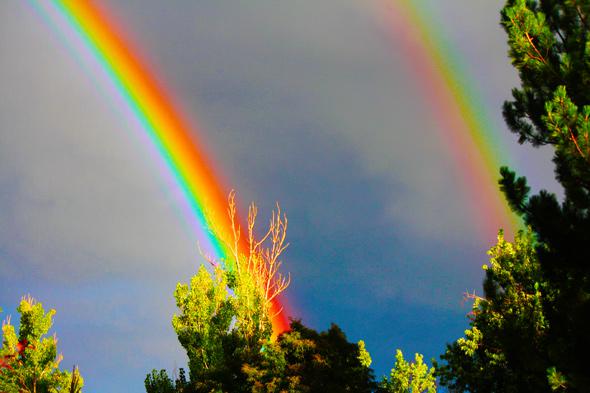The basic physics of a rainbow is pretty simple, really. Sunlight enters the front of a raindrop. It hits the back side of the drop, reflects, and then heads back out the front side again. The light bends a little bit when it enters and exits the drop—scientists get all fancy and call this refraction—and different colors bend by different amounts. The light bends change direction by a total of about 138°, but red light bends a little less, blue light a little more.
So, to see a rainbow, you face away from the Sun (180°), then look about 42° away from that point (180°–138°). The drops in an arc along that angle will then bend the light back toward you, and you get a rainbow, with the colors spread out a bit because they bend by different amounts.
Oh, wait. Did I say “arc”? Because technically, any raindrop 42° away from the anti-solar point (ooh, fancy science-speak again) will bend the light back to you. We see rainbows in the sky because in general the ground is close to you. When we look up toward the sky we see for a long way, and there are lots of raindrops along your eyeline that can add their light together to make the rainbow. When you look down, the ground gets in the way, there aren’t as many drops, and you don’t see a rainbow.
In general. Not always. For example, you could be in an airplane when it’s raining. If the Sun is in the right spot, and you look out the opposite side, you could in fact see a rainbow making a full circle … just like this:

Source: oskarslidums on reddit
Oh, wow! I knew scientifically this was possible, and I’ve heard pilots say they’ve seen them, but I’ve never actually seen a picture of one. That’s amazing.
Again, every raindrop in the air that’s 42° away from the spot in the sky opposite the Sun can bend the light back toward you. All those drops are the same distance from that point, and that defines the edge of a circle.
Even better, there’s a secondary bow, due to light reflecting twice inside each raindrop. That reverses the colors, so the secondary bow goes red to blue inside to outside. You can also see Alexander’s dark band in between them; drops located in that region bend light away from you, so it looks darker. Inside the primary bow it looks brighter because drops there bend light at you. The colors bent by drops there all overlap with each other, adding back together to create white light, so inside the primary bow there’s no color. I describe how all this works (with links) in a previous post. A little searching turned up another shot of a circular rainbow from the air, though it’s not quite all in the single picture. It shows good supernumerary arcs, though.
If you look carefully, the shadows on the ground inside the rainbow all seem to point to its center. That’s just geometric perspective; since the center of the rainbow has to be 180° around the sky from the Sun, shadows have to point in that direction!
By the way, you can get higher order rainbows; I learned just recently that the tertiary bow is in the direction toward the Sun, the fourth just outside it (and is very faint), while the fifth and sixth are just outside and inside the primary arc, respectively. I’d love to see those!
Happily, in Boulder, Colorado, we do get more than our fair share of bright rainbows. I checked my pictures from the magnificent double rainbow we had the other day (the one where I got the super-lucky shot of lightning going across it!) and played with the contrast, brightness, and color saturation. I didn’t see the fifth and sixth order bows, but now that I know they can be there, I’ll keep trying for them. And at least I got this fun, if garish, shot out of it.

Photo by Phil Plait
And the next time I’m in a plane looking out the anti-solar window, I’ll keep my eyes open for more than just glories …